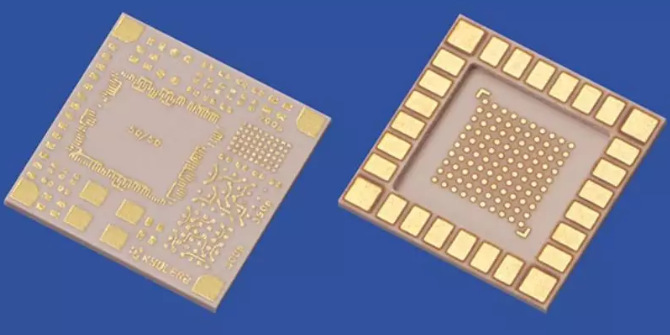Pure beryllium oxide (BeO) belongs to cubic crystal system with a density of 3.03 g / cm3. The melting point is 2570 ℃, and it has high thermal conductivity, which is almost equal to that of pure aluminum copper. The thermal conductivity λ is 200-250w / (m.k), and has good thermal shock resistance. Its dielectric constant is 6 – 7 (0.1MHz). The tangent of dielectric loss angle is about 4 × 10-4 (0.1ghz). The biggest disadvantage is that the powder is highly toxic and makes the contact wound difficult to heal. Beryllium oxide powder was sintered at high temperature with alumina and other ingredients. Making this kind of ceramics requires good protection. The volatility of beryllium oxide in the high temperature medium containing water vapor will increase. It will start to volatilize at 1000 ℃, and the volatilization will increase with the increase of temperature. This will bring difficulties to the production and some countries will not produce it any more. But the performance of the products is excellent, although the price is high, there is still a considerable demand.
3. Aluminum nitride (AlN)
AlN has two very important properties to note: one is high thermal conductivity, the other is the expansion coefficient matching with Si. The disadvantage is that even if there is a very thin oxide layer on the surface, the thermal conductivity will be affected. Only by strictly controlling the material and process, can the AlN substrate with good consistency be produced.
From the above reasons, we can know that alumina ceramics are still in a leading position in microelectronics, power electronics, Hybrid Microelectronics, power modules and other fields due to its superior comprehensive properties.
AlN can be stabilized up to 2200 ℃. The strength at room temperature is high, and the strength decreases slowly with the increase of temperature. It has good thermal conductivity and small coefficient of thermal expansion, so it is a good thermal shock resistant material. It is an ideal crucible material for melting and casting pure iron, aluminum or aluminum alloy. AlN is also an electrical insulator with good dielectric properties. It is also promising to be used as electrical components. AlN coating on GaAs surface can protect it from ion implantation during annealing. AlN is also a catalyst for the conversion of hexagonal boron nitride to cubic boron nitride. It can be synthesized from aluminum powder at 800 ~ 1000 ℃ in ammonia or nitrogen atmosphere. The product is white to gray blue powder. Or by the reaction of al2o3-c-n2 system at 1600 ~ 1750 ℃, the product is gray white powder. The coating can be prepared by vapor deposition in alcl3-nh3 system.
4. Silicon nitride (Si3N4)
Rogers introduced a new curamik series silicon nitride (Si3N4) ceramic substrate in 2012. Because silicon nitride has a higher mechanical strength than other ceramics, the new curamik? Substrate can help designers achieve a critical long life in harsh operating environments, as well as in HEV / EV and other renewable energy applications.
The flexural strength of the new ceramic substrate made of silicon nitride is higher than that of the substrate made of Al2O3 and AlN.
The fracture toughness of Si3N4 is even higher than that of alumina doped ceramics.
Up to now, the reliability of copper-clad ceramic substrates used in power modules has been limited by the lower flexural strength of the ceramics, which reduces the thermal cycling capacity. For applications where extreme thermal and mechanical stresses are integrated, such as hybrid electric vehicles and electric vehicles (HEV / EV), the ceramic substrates currently commonly used are not the best choice. The thermal expansion coefficients of substrate (ceramic) and conductor (copper) are very different, which will generate pressure on the bonding zone during thermal cycling, thus reducing the reliability. At this year’s PCIM exhibition, Rogers launched the curamik series silicon nitride (Si3N4) ceramic substrate, which will extend the life of power electronic modules by 10 times.
With the growth of HEV / EV and renewable energy applications, designers have found new ways to ensure the reliability of these electronic components needed to drive the development of challenging new technologies. Since the service life is 10 times or more longer than other ceramics used in power electronics, the silicon nitride substrate can provide the mechanical strength that is critical to achieving the necessary reliability requirements. The life of the ceramic substrate is measured by the number of thermal cycles that the substrate can withstand without delamination and other failures that affect the function and safety of the circuit. This test is usually done by cycling the sample from – 55 ° C to 125 ° C or 150 ° C.
“Our current test results (- 55 ° C to 150 ° C) indicate that the service life of the curamik silicon nitride substrate is more than ten times longer than that commonly used in the automotive market, especially HEV / EV,” said Manfred Goetz, product marketing manager for curamik. The use of silicon nitride substrate also greatly improves the life of the whole module. “
Extended service life is critical for all power module applications where large semiconductor wafers are directly bonded to the substrate, especially for SiC and Gan wafers with high junction temperature (up to 250 ° C). The average thermal conductivity of the substrate is more than 90 MW.
The mechanical strength of the new substrate enables us to use thinner ceramic layers, thus reducing thermal resistance, increasing power density and reducing system costs.
Compared with Al2O3 and AlN substrates, the flexural strength is improved a lot, which will benefit designers. The fracture toughness of silicon nitride is even higher than that of zirconia doped ceramics, and reaches 6.5 ~ 7 MPa / √ m at 90 w / MK.

